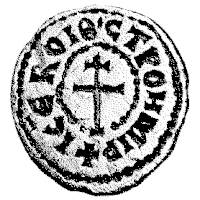
Cyril and Methodius were brothers, Byzantine Christian theologians and missionaries. For their work evangelizing the Slavs, they are known as the "Apostles to the Slavs".
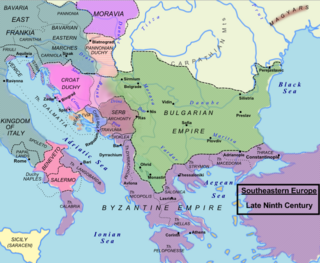
The Principality of Serbia was one of the early medieval states of the Serbs, located in the western regions of Southeastern Europe. It existed from the 8th century up to c. 969–971 and was ruled by the Vlastimirović dynasty. Its first ruler known by name was Višeslav who started ruling around 780. While by that time, starting from the year 680–681, the Bulgarian state had taken the lands to the east. Vlastimir resisted and defeated the Bulgarian army in a three-year-war (839–842), and the two powers lived in peace for some decades. Vlastimir's three sons succeeded in ruling Serbia together, although not for long; Serbia became a key part in the power struggle between the Byzantines and Bulgarians, predominantly allied with the Byzantines, which also resulted in major dynastic wars for a period of three decades. The principality was annexed in 924 by Simeon I and subjected to Bulgarian rule until 933 when Serbian prince Časlav was established as ruler of the Serbian land, becoming the most powerful ruler of the Vlastimirović dynasty.

The Serbian Orthodox Church is one of the autocephalous Eastern Orthodox Christian churches.

The House of Vlastimirović was the first Serbian royal dynasty, named after Prince Vlastimir, who was recognized by the Byzantine Empire. The dynasty was established with the Unknown Archon, who ruled during the reign of Emperor Heraclius (610–641). The Vlastimirović dynasty ruled in Serbia until the 940s/960s, when some of the Serbian lands were annexed by the Byzantine Empire.
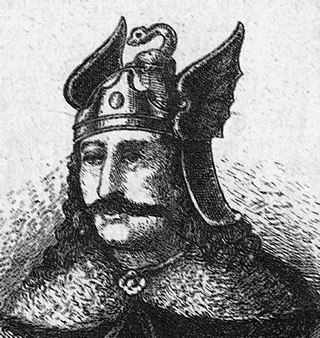
Časlav was Prince of the Serbs from c. 933 until his death in c. 943/960.
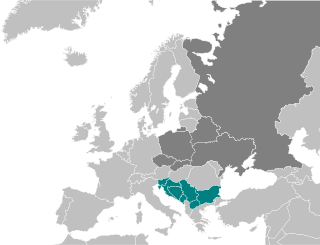
South Slavs are Slavic people who speak South Slavic languages and inhabit a contiguous region of Southeast Europe comprising the eastern Alps and the Balkan Peninsula. Geographically separated from the West Slavs and East Slavs by Austria, Hungary, Romania, and the Black Sea, the South Slavs today include Bosniaks, Bulgarians, Croats, Macedonians, Montenegrins, Serbs and Slovenes.
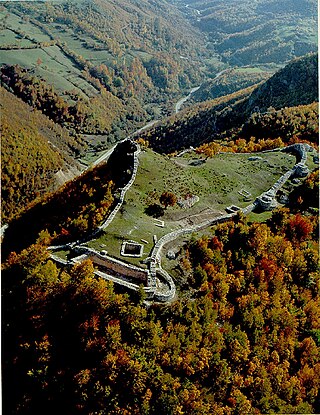
Ras, known in modern Serbian historiography as Stari Ras, is a medieval fortress and area located in the vicinity of former market-place of Staro Trgovište, some 10–11 kilometers (6.2–6.8 mi) west of modern-day city of Novi Pazar in Serbia.
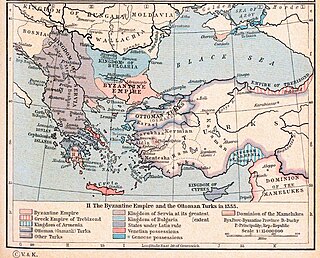
The History of the Serbs spans from the Early Middle Ages to present. Serbs, a South Slavic people, traditionally live mainly in Serbia, Montenegro, Bosnia and Herzegovina, Croatia and North Macedonia. A Serbian diaspora dispersed people of Serb descent to Western Europe, North America and Australia.
Grubeša Branislavljević was a medieval king and the ruler of Duklja from 1118 to 1125. After the Byzantine Empire defeated King George I of Duklja in 1118, Grubeša assumed the throne as a Byzantine protégé. The Byzantines entitled Grubeša the rule in Duklja, as well as providing him with an army that he would command against George, who was backed by the Grand Principality of Serbia under the rule of the Vukanović dynasty. Grubeša reigned until his death in 1125, when he was defeated by George. He is buried at the Church of Saint George in Bar.
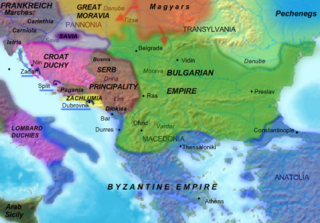
Petar Gojniković or Peter of Serbia was Prince of the Serbs from 892 to 917. He ruled and expanded the First Serbian Principality and won several wars against other family members that sought the crown. He was the first Serbian monarch with a Christian (non-Slavic) name.

Vlastimir was the Serbian prince from c. 830 until c. 851. Little is known of his reign. He held Serbia during the growing threat posed by the neighbouring, hitherto peaceful, First Bulgarian Empire, which had expanded significantly toward Serbia.
Mutimir was prince of the first Serbian Principality from ca. 850 until 891. He defeated the Bulgar army, and allied himself with the Byzantine emperor, and the Church in Serbia with the Ecumenical Patriarchate of Constantinople.
Pomorje, also known as the Lands of Pomorje, is a medieval term, used in Byzantine title, and at end of the 12th century, during the reign of Stefan Nemanja (1166–1196), inherited by Serbian monarchs, thus becoming part of the Serbian title, whose rulers were styled with the title: "crowned king and autocrat of all Serbian and coastal lands".
Pribislav was Prince of the Serbs for a year, in 891–892, before being deposed by his cousin Petar. He was the eldest son of Mutimir of the Vlastimirović dynasty, who ruled during the expanding and Christianization of Serbia.

The Church of the Holy Apostles Peter and Paul, commonly known as Church of St Peter or simply Peter's Church is a Serbian Orthodox church, the oldest intact church in Serbia and one of the oldest ones in the region, situated on a hill of Ras, the medieval capital of the Serbian Grand Principality (Rascia), in Novi Pazar, Serbia. It is part of the Stari Ras complex, an UNESCO World Heritage Site.

Pavle Branovic was the Prince of the Serbs from 917 to 921. He was put on the throne by the Bulgarian Tsar Symeon I of Bulgaria, who had imprisoned the previous prince, Petar after he had become a Byzantine ally. Pavle ruled for four years, before being defeated by Zaharija Pribislavljević, his cousin. Pavle was the son of Bran, the middle son of Mutimir of the Vlastimirović dynasty.

Zaharija Pribislavljević or Zaharija of Serbia was Prince of the Serbs from 922 to 924. He defeated his cousin Pavle in 922. Zaharija was the son of Pribislav, the eldest son of Mutimir of the first Serbian dynasty.

Eparchy of Raška and Prizren is one of the oldest eparchies of the Serbian Orthodox Church, featuring the seat of the Serbian Orthodox Church, the Serbian Patriarchal Monastery of Peć, as well as Serbian Orthodox Monastery of Visoki Dečani, which together are part of the UNESCO World Heritage sites of Serbia. More than 100 of the Eparchy's churches and monasteries were targeted for vandalism and destruction by Albanian nationalists after the Kosovo War and during the 2004 unrest in Kosovo.
The Catepanate of Ras was a province (catepanate) of the Byzantine Empire, established around 971 in central regions of early medieval Serbia, during the rule of Byzantine Emperor John Tzimiskes (969–976). The catepanate was named after the fortified town of Ras, eponymous for the historical region of Raška. The province was short-lived, and collapsed soon after 976, following the Byzantine retreat from the region after the restoration of the Bulgarian Empire.
Tibor Živković was a Serbian historian and Byzantinist who specialised in the period of the Early Middle Ages.

